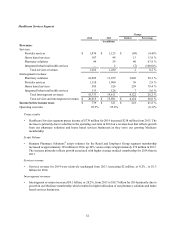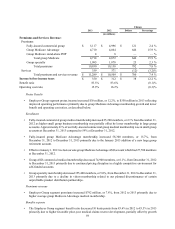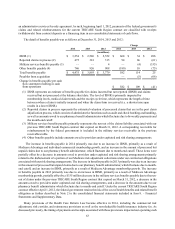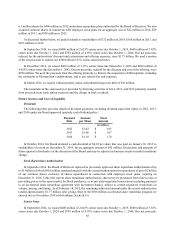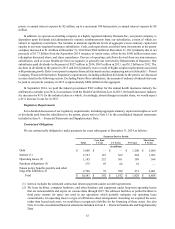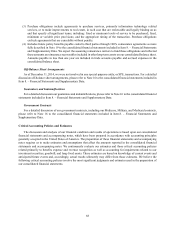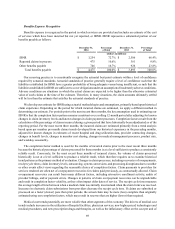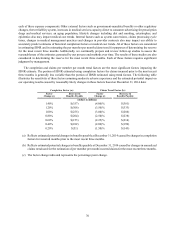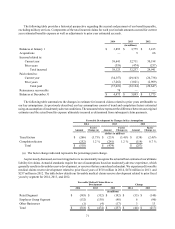Humana 2014 Annual Report Download - page 70
Download and view the complete annual report
Please find page 70 of the 2014 Humana annual report below. You can navigate through the pages in the report by either clicking on the pages listed below, or by using the keyword search tool below to find specific information within the annual report.
62
Cash and cash equivalents increased to $1.9 billion at December 31, 2014 from $1.1 billion at December 31, 2013.
The change in cash and cash equivalents for the years ended December 31, 2014, 2013 and 2012 is summarized as
follows:
2014 2013 2012
(in millions)
Net cash provided by operating activities $ 1,618 $ 1,716 $ 1,923
Net cash used in investing activities (63)(1,182)(1,965)
Net cash used in financing activities (758)(702)(29)
Increase (decrease) in cash and cash equivalents $ 797 $ (168)$ (71)
Cash Flow from Operating Activities
The change in operating cash flows over the three year period primarily results from the corresponding change in
earnings, enrollment activity, and the timing of working capital items as discussed below. Cash flows were positively
impacted by annual Medicare enrollment gains because premiums generally are collected in advance of claim payments
by a period of up to several months. In addition, 2014 operating cash flows were impacted by lower earnings and
increased receivables associated with the 3Rs, partially offset by an increase in benefits payable from growth in
membership.
Comparisons of our operating cash flows also are impacted by other changes in our working capital. The most
significant drivers of changes in our working capital are typically the timing of receipts for premiums and payments
of benefits expense. We illustrate these changes with the following summaries of receivables and benefits payable.
The detail of total net receivables was as follows at December 31, 2014, 2013 and 2012:
Change
2014 2013 2012 2014 2013 2012
(in millions)
Medicare $ 664 $ 576 $ 422 $ 88 $ 154 $ 86
Commercial and other 535 405 346 130 59 31
Military services 106 87 59 19 28 (409)
Allowance for doubtful accounts (137) (118) (94)(19)(24)(9)
Total net receivables $ 1,168 $ 950 $ 733 218 217 (301)
Reconciliation to cash flow
statement:
Provision for doubtful accounts 32 37 26
Receivables from disposition
(acquisition) 14 (3)(51)
Change in receivables per cash flow
statement resulting in cash from
operations $ 264 $ 251 $ (326)
Medicare receivables are impacted by revenue growth associated with growth in individual and group Medicare
membership and the timing of accruals and related collections associated with the CMS risk-adjustment model.
The increases in commercial and other receivables in 2014 and 2013 primarily are due to growth in the business.
In addition, the increase in commercial and other receivables in 2014 is primarily due to the commercial risk adjustment
provision of the Health Care Reform Law which became effective in 2014.
Military services receivables at December 31, 2014 and 2013 primarily consist of administrative services only fees
owed from the federal government for administrative services provided under our current TRICARE South Region
contract. The $409 million decrease in military services receivables from December 31, 2011 to December 31, 2012
primarily resulted from the transition to our current TRICARE South Region contract which we account for similar to


